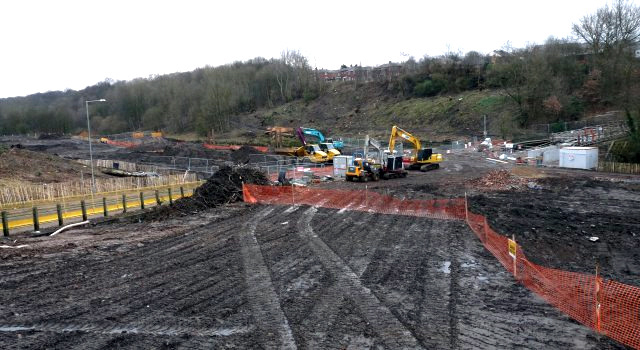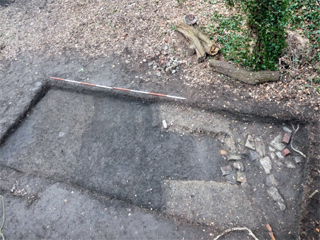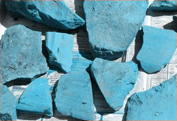
The construction of a dam (or 'Gated Attenuation Structure') across the Douglas Valley, behind Tessco's, is now well underway. The barrage is designed to provide protection for Wigan from a 1 in 20 year storm surge, by collecting the water in the valley for up to 1.3km upstream. Serious flooding has occurred in Wigan over the centuries, with the most recent being in 1966 and 2000 when areas around Poolstock were flooded. This new scheme has been controversial as it involves the whole of the valley, between the Riverway bypass and the Haigh Hall road, coming under excavation. In the middle of this is where the Sutton Corn Mill and the Bottling Wood community used to be (disappearing in the 1930s -see newsletter No.117). In 2008 Oxford Archaeology North carried out a desktop survey and GSB Prospection did geophysics in the area to see if they could detect any remains of the mill.
Unfortunately only demolition debris was detected. This is what the contractors are now uncovering as the ground is bulldozed in preparation for the dam. This once attractive green valley, close to the heart of Wigan, is now looking in a sorry state but the site engineer assures me that, once construction has finished, the area will be landscaped and returned to (or even better than) its previous condition. Let's hope so.
New Chairman
The recent bad weather almost caused the cancelation of our AGM last months; however I would like to thank all those who braved the elements to come along and elect our new chairman, Eric Walter. Eric is a longstanding member of the Society who has great enthusiasm for archaeology. His methodical approach to the subject will stand us in good stead for the future and I'm sure that, under his stewardship, the Society will go from strength to strength.
Rectory update

The bad weather has also played havoc with our activities at the Rectory with only a few visits possible this year. We have, however, managed to remove the remnant of the cinder and black soil layers which covered almost the whole of our excavated area. The rain and snow has also been kind in cleaning the path and stone features. Our excavations have now enabled us to see the full extent of the black grit layer, which seems to stretch in a band about two metres wide across the middle of the site. It lies half underneath the pebble path and it appears to have a slight camber (with a noticeable drop off on both edges). What appear to be wheel ruts can be detected on its surface, giving the suggestion that this maybe an earlier cart track. We had assumed that the pebble path was built at the same time as new hall in 1875 (when old Frog Lane was diverted). However, if our interpretation is correct, then it was the cart track first to be built when the lane was moved, with the pebble path coming some time later. Further excavations will no doubt reveal more. If you are interest in talking part, contact myself or Eric at our next meeting.
Da Vinci the Genius
This is the title of the current exhibition at the Museum of Science and Industry in Manchester. Interactive large scale models are on display together with 3D animations of his best known paintings and sculptures. His most famous painting, the Mona Lisa has been studied using ultra-high resolution digital infrared photography to reveal its original colour and 25 other previously undetected secrets. For more details visit www.mosi.org and www.davincithegenius.com
Next Meeting
Wednesday 3rd March in the lounge of the Upper Morris Street Working Men's Club (off Greenough Street), starting at 7.30 pm as usual. This month we have
Alan Michenson, a local historian who will be giving us a talk on Aspects of the History of Standish. This will include an item on the Roman road leading north through Standish. As mentioned last month this subject is close to our hearts having carried out a field trip in this area in December. It will be very interesting to hear what Alan has to say on this subject.
Hope to see you there - BA
|



